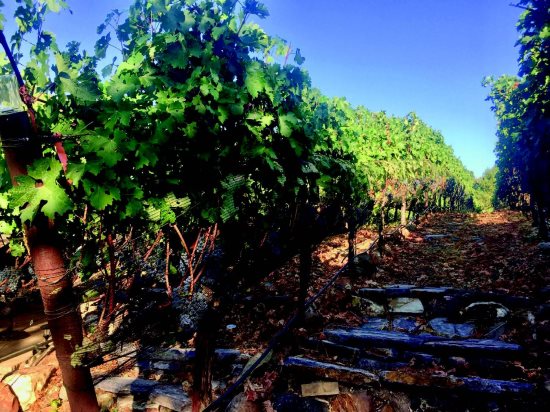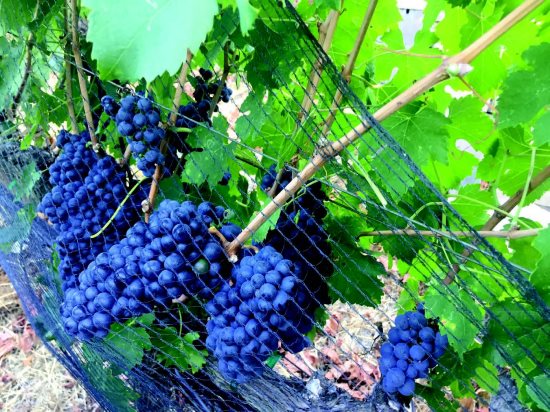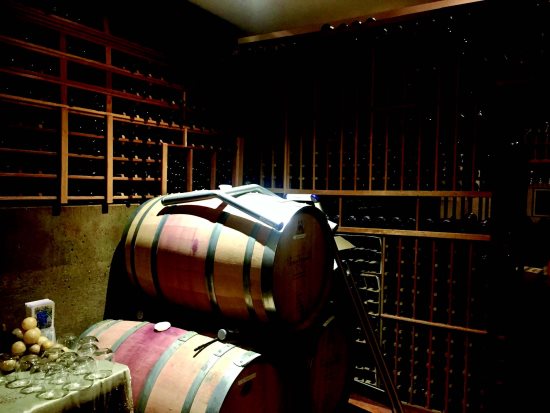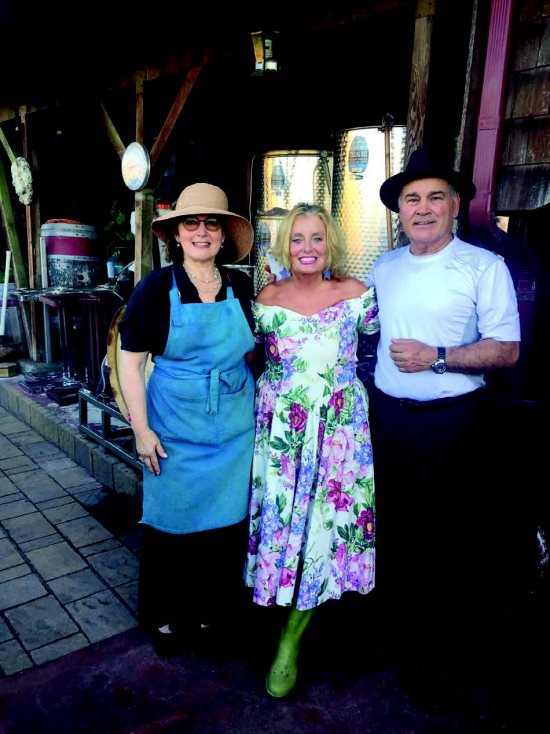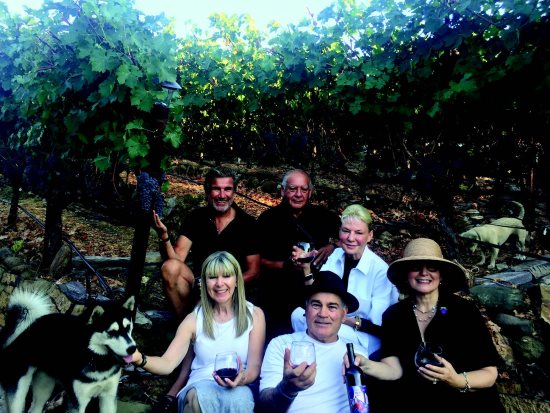 | | | Lamorinda growers enjoy a glass of wine in the Captain's Cabernet Sauvignon vineyard, from left: Eero Teerikorpi of Noet Vineyard in Moraga, David Ledesma, an Orinda grower, Michel Smith, and Orinda grower, Susan Captain, holding a bottle of Captain's Petit Verdot 2011, Sal Captain, Tiina Teerikorpi of Noet Vineyard, and dogs Cleopatra and Shea. Photo Cynthia Brian | | | | | | Wherever you travel in California, you'll witness miles and miles of beautiful vineyards. Over 90 percent of all the wine made in America is produced in our golden state. The cultivation of Vitis vinefera dates back to the Neolithic period, more than 7,000 years ago. Grape growing and the making of wine are as old as civilization itself.
 In California, Father Junipero Serra planted the first vineyard at Mission San Diego Alcala in 1779 and the Spanish continued planting grapes at each mission they founded to provide wine for the Mass and the masses. The Gold Rush ushered in a time of great demand for wine as prospectors and settlers increased the population of California.
In California, Father Junipero Serra planted the first vineyard at Mission San Diego Alcala in 1779 and the Spanish continued planting grapes at each mission they founded to provide wine for the Mass and the masses. The Gold Rush ushered in a time of great demand for wine as prospectors and settlers increased the population of California.
 Lamorinda became a wine region in 1880 when the Trelut brothers became squatters at the top of Bollinger Canyon in Moraga, cultivated grapes, and readied the wine. In 1887 Theodore Wagner (Wagner Ranch in Orinda) supplied grapes to immigrant Italians in San Francisco's North Beach. By 1907, Serafino Rossi made the four- to five-hour trek to Oakland over Fish Ranch Road from Lafayette to sell his grapes and produce. In the late 19th century a parasite that feeds on and destroys the roots of vines, Phylloxera infested vineyards. The national Prohibition Act of 1919 uprooted vineyards, destroyed cellars, and outlawed the sale and consumption of alcohol. Between these two major calamities, the wine industry in America collapsed.
Lamorinda became a wine region in 1880 when the Trelut brothers became squatters at the top of Bollinger Canyon in Moraga, cultivated grapes, and readied the wine. In 1887 Theodore Wagner (Wagner Ranch in Orinda) supplied grapes to immigrant Italians in San Francisco's North Beach. By 1907, Serafino Rossi made the four- to five-hour trek to Oakland over Fish Ranch Road from Lafayette to sell his grapes and produce. In the late 19th century a parasite that feeds on and destroys the roots of vines, Phylloxera infested vineyards. The national Prohibition Act of 1919 uprooted vineyards, destroyed cellars, and outlawed the sale and consumption of alcohol. Between these two major calamities, the wine industry in America collapsed.
 The resurgence for demand of California wines didn't occur until after 1976 when California wines won top awards for both red and white varietals in a blind tasting at the historic upheaval competition against the best of Bordeaux vintages known as "The Judgment of Paris." The renaissance of viticulture in California began anew.
The resurgence for demand of California wines didn't occur until after 1976 when California wines won top awards for both red and white varietals in a blind tasting at the historic upheaval competition against the best of Bordeaux vintages known as "The Judgment of Paris." The renaissance of viticulture in California began anew.
 Here in Lamorinda, amateur farmers were experimenting with growing grapes again, too. The climates and microclimates are protected from coastal cooling, the slopes are carved from young sedimentary rock, the soil's content is mostly clay, sunshine is abundant, and drainage is satisfactory. With homes built on large lots, small vineyards began to flourish.
Here in Lamorinda, amateur farmers were experimenting with growing grapes again, too. The climates and microclimates are protected from coastal cooling, the slopes are carved from young sedimentary rock, the soil's content is mostly clay, sunshine is abundant, and drainage is satisfactory. With homes built on large lots, small vineyards began to flourish.
 Having grown up in the vineyards of Napa County, when I first heard about Captain Vineyards, I thought the name was a charming play of viticulture publicity. Then I learned that "Captain" was the surname of the owners, Sal and Susan Captain who moved to Moraga in 1989 to raise their four children. Sal was a vice president, engineer, and researcher at a multinational medical device company, while Susan spent her days carpooling, volunteering, and juggling kids as a hands-on mom. Being wine aficionados, they had traveled extensively to many wine regions of the world and realized that their hillside in Moraga possessed the perfect terroir, soil, slope and climate to grow grapes. Susan, with a bachelor's in statistics, especially admired the farming culture and went to work to learn as much as possible about enology and viticulture, taking classes at UC Davis, Sonoma City College, Napa Community College as well as attending symposiums and conferences in related subjects. By forming friendships with vintners from many states and countries, the Captains learned quickly.
Having grown up in the vineyards of Napa County, when I first heard about Captain Vineyards, I thought the name was a charming play of viticulture publicity. Then I learned that "Captain" was the surname of the owners, Sal and Susan Captain who moved to Moraga in 1989 to raise their four children. Sal was a vice president, engineer, and researcher at a multinational medical device company, while Susan spent her days carpooling, volunteering, and juggling kids as a hands-on mom. Being wine aficionados, they had traveled extensively to many wine regions of the world and realized that their hillside in Moraga possessed the perfect terroir, soil, slope and climate to grow grapes. Susan, with a bachelor's in statistics, especially admired the farming culture and went to work to learn as much as possible about enology and viticulture, taking classes at UC Davis, Sonoma City College, Napa Community College as well as attending symposiums and conferences in related subjects. By forming friendships with vintners from many states and countries, the Captains learned quickly.
 Following cultivating techniques from Tuscany, the French Rhone Valley, and the German Heidelberg region as well as Napa Valley their hillside acreage was planted on their 20-35 percent slopes ensuring 10 hours of summer sunlight, excellent drainage, and soil erosion prevention. The vines and rows of their six red varietals - Pinot Noir, Petite Syrah, Grenache, Cabernet Sauvignon, Petit Verdot, and Cab Franc - are established in a 3 by 5 foot matrix with vines spur trained to limit production to less than five pounds per vine resulting in a complexity of flavor and body. As dry farmers, the grapes rely on rainfall or minimal watering only to keep the vines alive, not to increase production. Dry farming results in bolder body, richness and character.
Following cultivating techniques from Tuscany, the French Rhone Valley, and the German Heidelberg region as well as Napa Valley their hillside acreage was planted on their 20-35 percent slopes ensuring 10 hours of summer sunlight, excellent drainage, and soil erosion prevention. The vines and rows of their six red varietals - Pinot Noir, Petite Syrah, Grenache, Cabernet Sauvignon, Petit Verdot, and Cab Franc - are established in a 3 by 5 foot matrix with vines spur trained to limit production to less than five pounds per vine resulting in a complexity of flavor and body. As dry farmers, the grapes rely on rainfall or minimal watering only to keep the vines alive, not to increase production. Dry farming results in bolder body, richness and character.
 When Sal retired in 2008, he devoted himself to becoming a winemaker with a bonded winery. Captain Vineyards was the first green winery in Contra Costa County dedicated to utilizing sustainable vineyard practices. Sal and Susan have designed and established 12 vineyards for other landowners ranging in size from 35 vines to over 3,000 vines.
When Sal retired in 2008, he devoted himself to becoming a winemaker with a bonded winery. Captain Vineyards was the first green winery in Contra Costa County dedicated to utilizing sustainable vineyard practices. Sal and Susan have designed and established 12 vineyards for other landowners ranging in size from 35 vines to over 3,000 vines.
 Sal's "grape escape" hasn't allowed him to desert his engineering background. He orients vineyards to the topography while maintaining aesthetics. Soils characteristics are never adjusted with chemicals. Synthetic pesticides or herbicides are not used or recommended. Instead all vineyard and winery waste and output is recycled back to the soil. Although his expertise is in demand, he says that he talks more people out of planting a vineyard than planting one.
Sal's "grape escape" hasn't allowed him to desert his engineering background. He orients vineyards to the topography while maintaining aesthetics. Soils characteristics are never adjusted with chemicals. Synthetic pesticides or herbicides are not used or recommended. Instead all vineyard and winery waste and output is recycled back to the soil. Although his expertise is in demand, he says that he talks more people out of planting a vineyard than planting one.
 In 2005, The Lamorinda Winegrower's Association was established to create a community of people who share a passion for grape growing and wine making. One of the stated missions of the LWGA was to establish an AVA (American Viticultural Area) for Lamorinda. With Susan Captain as president of LWGA, with the help of Dave Rey, AVA committee leader, and all of the members of LWGA, that goal was accomplished on March 25, 2016. At application 139 acres of planted vines and future planned plantings were recorded. The AVA for Lamorinda covers 29,369 acres making Lafayette, Orinda and Moraga official wine country destinations.
In 2005, The Lamorinda Winegrower's Association was established to create a community of people who share a passion for grape growing and wine making. One of the stated missions of the LWGA was to establish an AVA (American Viticultural Area) for Lamorinda. With Susan Captain as president of LWGA, with the help of Dave Rey, AVA committee leader, and all of the members of LWGA, that goal was accomplished on March 25, 2016. At application 139 acres of planted vines and future planned plantings were recorded. The AVA for Lamorinda covers 29,369 acres making Lafayette, Orinda and Moraga official wine country destinations.
 There are currently 76 members of the LWGA although there are many households who grow grapes but have not joined the group. By federal law, for a winery to post the "Lamorinda" AVA on a bottle, 85 percent of the grapes must be grown in Lafayette, Moraga or Orinda. If a winery needs other grapes to blend with their wine, it is allowed as long as the outside grape content is less than 15 percent. This protects the unique qualities and individuality of a region.
There are currently 76 members of the LWGA although there are many households who grow grapes but have not joined the group. By federal law, for a winery to post the "Lamorinda" AVA on a bottle, 85 percent of the grapes must be grown in Lafayette, Moraga or Orinda. If a winery needs other grapes to blend with their wine, it is allowed as long as the outside grape content is less than 15 percent. This protects the unique qualities and individuality of a region.
 Two other intriguing local growers, both members of the LWGA, have vineyards planted and managed by Sal and Susan Captain. NOET Vineyard, owned by Kristiina and Eero Teerikorpi, grows solely Cabernet Sauvignon. Eero and Tiina continue the great tradition of excellent California Cabs grown by immigrants from Finland, started by a sea captain and an entrepreneur Gustave Niebaum. In the late 1800s, Gustave was one of the early premier wine growers in California on his Inglenook winery. (As an interesting side note, my mother was born across the street in Rutherford from Inglenook on the property of Beaulieu Winery.) To fully close the circle, Eero Teerikorpi is also an entrepreneur, navy officer and avid sailor. After 15 years living in London and commuting to Milan working in the fashion industry, Michel Smith, with her husband David Ledesma came to Northern California where they discovered a hidden gem of a mid-century home complete with a vineyard planted with Cabernet Sauvignon and Merlot on an Orinda hillside. They credit the Captains with passionately training, teaching, and managing the vineyard while making the wine that comes from their grapes.
Two other intriguing local growers, both members of the LWGA, have vineyards planted and managed by Sal and Susan Captain. NOET Vineyard, owned by Kristiina and Eero Teerikorpi, grows solely Cabernet Sauvignon. Eero and Tiina continue the great tradition of excellent California Cabs grown by immigrants from Finland, started by a sea captain and an entrepreneur Gustave Niebaum. In the late 1800s, Gustave was one of the early premier wine growers in California on his Inglenook winery. (As an interesting side note, my mother was born across the street in Rutherford from Inglenook on the property of Beaulieu Winery.) To fully close the circle, Eero Teerikorpi is also an entrepreneur, navy officer and avid sailor. After 15 years living in London and commuting to Milan working in the fashion industry, Michel Smith, with her husband David Ledesma came to Northern California where they discovered a hidden gem of a mid-century home complete with a vineyard planted with Cabernet Sauvignon and Merlot on an Orinda hillside. They credit the Captains with passionately training, teaching, and managing the vineyard while making the wine that comes from their grapes.
 When to harvest is a combination of science and taste. Now that the grape skins are soft, the seeds are brown and crunchy, the berries exude that elusive bouquet of blackberry, plum and blueberry. Once the sugar content or Brix has been measured (never more than 24 Brix or the alcohol buzz is overpowering), the harvest commences with clusters picked by hand. In recent years it's been challenging finding reliable and knowledgeable pickers for hire. Families, friends and wine members assist in this time-consuming, centuries old ritual.
When to harvest is a combination of science and taste. Now that the grape skins are soft, the seeds are brown and crunchy, the berries exude that elusive bouquet of blackberry, plum and blueberry. Once the sugar content or Brix has been measured (never more than 24 Brix or the alcohol buzz is overpowering), the harvest commences with clusters picked by hand. In recent years it's been challenging finding reliable and knowledgeable pickers for hire. Families, friends and wine members assist in this time-consuming, centuries old ritual.
 After the grapes are picked, the artistry begins. Grapes are the only fruits that possess the necessary esters, acids, and tannins to make a consistent and stable wine. The acidity, flavor and sweetness need to be perfectly balanced. Although every wine master varies the technique, the five basic steps to the winemaking process are harvesting, crushing and pressing, fermentation, clarification, and aging and bottling. Sal Captain likes to use new French oak barrels for the first 12 months. He then transfers the juice to older barrels for 36 to 50 months for his Petit Verdot, Petite Sirah, and Cabernet. The Pinot Noir is aged for 24 to 30 months.
After the grapes are picked, the artistry begins. Grapes are the only fruits that possess the necessary esters, acids, and tannins to make a consistent and stable wine. The acidity, flavor and sweetness need to be perfectly balanced. Although every wine master varies the technique, the five basic steps to the winemaking process are harvesting, crushing and pressing, fermentation, clarification, and aging and bottling. Sal Captain likes to use new French oak barrels for the first 12 months. He then transfers the juice to older barrels for 36 to 50 months for his Petit Verdot, Petite Sirah, and Cabernet. The Pinot Noir is aged for 24 to 30 months.
 The 2017 vintage will produce excellent wines as the bloom was fantastic and the berries are spectacular. How privileged we are to have dedicated grape growers who share their talents and time to bring us the gift of wines from the vines.
The 2017 vintage will produce excellent wines as the bloom was fantastic and the berries are spectacular. How privileged we are to have dedicated grape growers who share their talents and time to bring us the gift of wines from the vines.
 Dionysus, the Greek god of grapes, wine, and winemaking and his Roman counterpart, Bacchus raise their mutual glasses in admiration after a visit to the vineyards of Lamorinda.
Dionysus, the Greek god of grapes, wine, and winemaking and his Roman counterpart, Bacchus raise their mutual glasses in admiration after a visit to the vineyards of Lamorinda.
 Salute!
Salute!
 Happy Gardening and Happy Growing!
Happy Gardening and Happy Growing!

|

